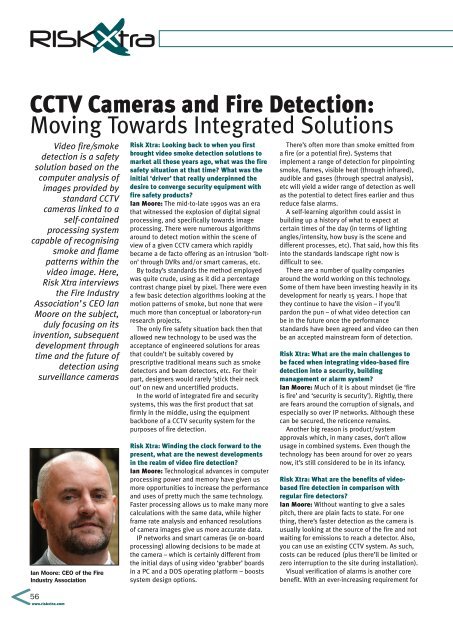RiskXtraDecember2018
You also want an ePaper? Increase the reach of your titles
YUMPU automatically turns print PDFs into web optimized ePapers that Google loves.
x<br />
RISKXtra<br />
CCTV Cameras and Fire Detection:<br />
Moving Towards Integrated Solutions<br />
Video fire/smoke<br />
detection is a safety<br />
solution based on the<br />
computer analysis of<br />
images provided by<br />
standard CCTV<br />
cameras linked to a<br />
self-contained<br />
processing system<br />
capable of recognising<br />
smoke and flame<br />
patterns within the<br />
video image. Here,<br />
Risk Xtra interviews<br />
the Fire Industry<br />
Association’s CEO Ian<br />
Moore on the subject,<br />
duly focusing on its<br />
invention, subsequent<br />
development through<br />
time and the future of<br />
detection using<br />
surveillance cameras<br />
Ian Moore: CEO of the Fire<br />
Industry Association<br />
Risk Xtra: Looking back to when you first<br />
brought video smoke detection solutions to<br />
market all those years ago, what was the fire<br />
safety situation at that time? What was the<br />
initial ‘driver’ that really underpinned the<br />
desire to converge security equipment with<br />
fire safety products?<br />
Ian Moore: The mid-to-late 1990s was an era<br />
that witnessed the explosion of digital signal<br />
processing, and specifically towards image<br />
processing. There were numerous algorithms<br />
around to detect motion within the scene of<br />
view of a given CCTV camera which rapidly<br />
became a de facto offering as an intrusion ‘bolton’<br />
through DVRs and/or smart cameras, etc.<br />
By today’s standards the method employed<br />
was quite crude, using as it did a percentage<br />
contrast change pixel by pixel. There were even<br />
a few basic detection algorithms looking at the<br />
motion patterns of smoke, but none that were<br />
much more than conceptual or laboratory-run<br />
research projects.<br />
The only fire safety situation back then that<br />
allowed new technology to be used was the<br />
acceptance of engineered solutions for areas<br />
that couldn’t be suitably covered by<br />
prescriptive traditional means such as smoke<br />
detectors and beam detectors, etc. For their<br />
part, designers would rarely ‘stick their neck<br />
out’ on new and uncertified products.<br />
In the world of integrated fire and security<br />
systems, this was the first product that sat<br />
firmly in the middle, using the equipment<br />
backbone of a CCTV security system for the<br />
purposes of fire detection.<br />
Risk Xtra: Winding the clock forward to the<br />
present, what are the newest developments<br />
in the realm of video fire detection?<br />
Ian Moore: Technological advances in computer<br />
processing power and memory have given us<br />
more opportunities to increase the performance<br />
and uses of pretty much the same technology.<br />
Faster processing allows us to make many more<br />
calculations with the same data, while higher<br />
frame rate analysis and enhanced resolutions<br />
of camera images give us more accurate data.<br />
IP networks and smart cameras (ie on-board<br />
processing) allowing decisions to be made at<br />
the camera – which is certainly different from<br />
the initial days of using video ‘grabber’ boards<br />
in a PC and a DOS operating platform – boosts<br />
system design options.<br />
There’s often more than smoke emitted from<br />
a fire (or a potential fire). Systems that<br />
implement a range of detection for pinpointing<br />
smoke, flames, visible heat (through infrared),<br />
audible and gases (through spectral analysis),<br />
etc will yield a wider range of detection as well<br />
as the potential to detect fires earlier and thus<br />
reduce false alarms.<br />
A self-learning algorithm could assist in<br />
building up a history of what to expect at<br />
certain times of the day (in terms of lighting<br />
angles/intensity, how busy is the scene and<br />
different processes, etc). That said, how this fits<br />
into the standards landscape right now is<br />
difficult to see.<br />
There are a number of quality companies<br />
around the world working on this technology.<br />
Some of them have been investing heavily in its<br />
development for nearly 15 years. I hope that<br />
they continue to have the vision – if you’ll<br />
pardon the pun – of what video detection can<br />
be in the future once the performance<br />
standards have been agreed and video can then<br />
be an accepted mainstream form of detection.<br />
Risk Xtra: What are the main challenges to<br />
be faced when integrating video-based fire<br />
detection into a security, building<br />
management or alarm system?<br />
Ian Moore: Much of it is about mindset (ie ‘fire<br />
is fire’ and ‘security is security’). Rightly, there<br />
are fears around the corruption of signals, and<br />
especially so over IP networks. Although these<br />
can be secured, the reticence remains.<br />
Another big reason is product/system<br />
approvals which, in many cases, don’t allow<br />
usage in combined systems. Even though the<br />
technology has been around for over 20 years<br />
now, it’s still considered to be in its infancy.<br />
Risk Xtra: What are the benefits of videobased<br />
fire detection in comparison with<br />
regular fire detectors?<br />
Ian Moore: Without wanting to give a sales<br />
pitch, there are plain facts to state. For one<br />
thing, there’s faster detection as the camera is<br />
usually looking at the source of the fire and not<br />
waiting for emissions to reach a detector. Also,<br />
you can use an existing CCTV system. As such,<br />
costs can be reduced (plus there’ll be limited or<br />
zero interruption to the site during installation).<br />
Visual verification of alarms is another core<br />
benefit. With an ever-increasing requirement for<br />
56<br />

















